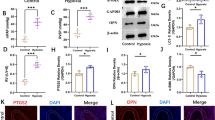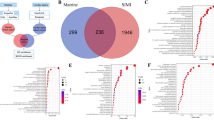Abstract
Salidroside shows an inhibitory effect on myocardial ischemia/reperfusion (I/R) injury; however, the underlying mechanism remains to be explored. The present work analyzes the mechanism that drives salidroside to ameliorate I/R-induced human cardiomyocyte injury. Human cardiomyocytes were subjected to I/R treatment to simulate a myocardial infarction cell model. Cell viability, cell proliferation, and cell apoptosis were analyzed by CCK-8 assay, EdU assay, and flow cytometry analysis, respectively. RNA expression levels of circ_0097682, miR-671-5p, and F-box and ubiquitin-specific peptidase 46 (USP46) were detected by qRT-PCR. Protein expression was measured by Western blotting assay. The levels of IL-6, IL-1β, and TNF-α in cell supernatant were detected by enzyme-linked immunosorbent assays. Salidroside treatment relieved I/R-induced inhibitory effect on AC16 cell proliferation and promoting effects on cell apoptosis, inflammation, and oxidative stress. Salidroside inhibited circ_0097682 expression in I/R-treated AC16 cells. Salidroside-mediated inhibition of I/R-induced cell injury involved the downregulation of circ_0097682 expression. In addition, circ_0097682 bound to miR-671-5p in AC16 cells, and miR-671-5p inhibitors rescued salidroside pretreatment-mediated effects in I/R-treated AC16 cells. Moreover, miR-671-5p targeted USP46 in AC16 cells, and USP46 introduction partially relieved circ_0097682 depletion or salidroside pretreatment-induced effects in I/R-treated AC16 cells. Salidroside ameliorated I/R-induced AC16 cell injury by inhibiting the circ_0097682/miR-671-5p/USP46 pathway.








Similar content being viewed by others
Data Availability
Not applicable.
References
White, H. D., Thygesen, K., Alpert, J. S., & Jaffe, A. S. (2014). Clinical implications of the third universal definition of myocardial infarction. Heart, 100, 424–432.
Wang, Z. Y., Liu, X. X., & Deng, Y. F. (2022). Negative feedback of SNRK to circ-SNRK regulates cardiac function post-myocardial infarction. Cell Death and Differentiation, 29, 709–721.
Yang, H. T., Xiu, W. J., Zheng, Y. Y., Liu, F., Gao, Y., Ma, X., et al. (2019). Invasive reperfusion after 12 hours of the symptom onset remains beneficial in patients with ST-segment elevation myocardial infarction: Evidence from a meta-analysis of published data. Cardiology Journal, 26, 333–342.
Chen, P., Liu, J., Ruan, H., Zhang, M., Wu, P., Yimei, D., et al. (2019). Protective effects of Salidroside on cardiac function in mice with myocardial infarction. Science and Reports, 9, 18127.
Yu, S., Liu, M., Gu, X., & Ding, F. (2008). Neuroprotective effects of salidroside in the PC12 cell model exposed to hypoglycemia and serum limitation. Cellular and Molecular Neurobiology, 28, 1067–1078.
Wang, H., Ding, Y., Zhou, J., Sun, X., & Wang, S. (2009). The in vitro and in vivo antiviral effects of salidroside from Rhodiola rosea L. against coxsackievirus B3. Phytomedicine, 16, 146–155.
Wu, Y. L., Piao, D. M., Han, X. H., & Nan, J. X. (2008). Protective effects of salidroside against acetaminophen-induced toxicity in mice. Biological and Pharmaceutical Bulletin, 31, 1523–1529.
Guan, S., Feng, H., Song, B., Guo, W., Xiong, Y., Huang, G., et al. (2011). Salidroside attenuates LPS-induced pro-inflammatory cytokine responses and improves survival in murine endotoxemia. International Immunopharmacology, 11, 2194–2199.
Ming, D. S., Hillhouse, B. J., Guns, E. S., Eberding, A., Xie, S., Vimalanathan, S., et al. (2005). Bioactive compounds from Rhodiola rosea (Crassulaceae). Phytotherapy Research, 19, 740–743.
Zhong, H., Xin, H., Wu, L. X., & Zhu, Y. Z. (2010). Salidroside attenuates apoptosis in ischemic cardiomyocytes: A mechanism through a mitochondria-dependent pathway. Journal of Pharmacological Sciences, 114, 399–408.
Yu, C. Y., & Kuo, H. C. (2019). The emerging roles and functions of circular RNAs and their generation. Journal of Biomedical Science, 26, 29.
Zhu, G., Chang, X., Kang, Y., Zhao, X., Tang, X., Ma, C., et al. (2012). CircRNA: A novel potential strategy to treat thyroid cancer (Review). International Journal of Molecular Medicine. https://doi.org/10.3892/ijmm.2021.5034
Zhang, F., Zhang, R., Zhang, X., Wu, Y., Li, X., Zhang, S., et al. (2018). Comprehensive analysis of circRNA expression pattern and circRNA-miRNA-mRNA network in the pathogenesis of atherosclerosis in rabbits. Aging (Albany NY)., 10, 2266–2283.
Altesha, M. A., Ni, T., Khan, A., Liu, K., & Zheng, X. (2019). Circular RNA in cardiovascular disease. Journal of Cellular Physiology, 234, 5588–5600.
Zheng, H., Huang, S., Wei, G., Sun, Y., Li, C., Si, X., et al. (2022). CircRNA Samd4 induces cardiac repair after myocardial infarction by blocking mitochondria-derived ROS output. Molecular Therapy, 30, 3477–3498.
Liu, X., Wang, M., Li, Q., Liu, W., Song, Q., & Jiang, H. (2022). CircRNA ACAP2 induces myocardial apoptosis after myocardial infarction by sponging miR-29. Minerva Medica, 113, 128–134.
Jin, P., Li, L. H., Shi, Y., & Hu, N. B. (2021). Salidroside inhibits apoptosis and autophagy of cardiomyocyte by regulation of circular RNA hsa_circ_0000064 in cardiac ischemia-reperfusion injury. Gene, 767, 145075.
Yin, L., Tang, Y., & Jiang, M. (2021). Research on the circular RNA bioinformatics in patients with acute myocardial infarction. Journal of Clinical Laboratory Analysis, 35, e23621.
Correia, C., Koshkin, A., Carido, M., Espinha, N., Šarić, T., Lima, P. A., et al. (2016). Effective hypothermic storage of human pluripotent stem cell-derived cardiomyocytes compatible with global distribution of cells for clinical applications and toxicology testing. Stem Cells Translational Medicine, 5, 658–669.
Correia, C., Koshkin, A., Duarte, P., Hu, D., Carido, M., Sebastião, M. J., et al. (2018). 3D aggregate culture improves metabolic maturation of human pluripotent stem cell derived cardiomyocytes. Biotechnology and Bioengineering., 115, 630–644.
Wang, X., Ren, L., Chen, S., Tao, Y., Zhao, D., & Wu, C. (2022). Long non-coding RNA MIR4435-2HG/microRNA-125a-5p axis is involved in myocardial ischemic injuries. Bioengineered, 13, 10707–10720.
Sebastião, M. J., Serra, M., Pereira, R., Palacios, I., Gomes-Alves, P., & Alves, P. M. (2019). Human cardiac progenitor cell activation and regeneration mechanisms: Exploring a novel myocardial ischemia/reperfusion in vitro model. Stem Cell Research & Therapy, 10, 77.
Sun, D., Chen, L., Lv, H., Gao, Y., Liu, X., & Zhang, X. (2020). Circ_0058124 Upregulates MAPK1 Expression to Promote Proliferation, Metastasis and Metabolic Abilities in Thyroid Cancer Through Sponging miR-940. Oncotargets and Therapy, 13, 1569–1581.
Zhuang, W., Yue, L., Dang, X., Chen, F., Gong, Y., Lin, X., et al. (2019). Rosenroot (Rhodiola): Potential applications in aging-related diseases. Aging & Disease, 10, 134–146.
Kong, Y. H., & Xu, S. P. (2018). Salidroside prevents skin carcinogenesis induced by DMBA/TPA in a mouse model through suppression of inflammation and promotion of apoptosis. Oncology Reports, 39, 2513–2526.
Xu, N., Huang, F., Jian, C., Qin, L., Lu, F., Wang, Y., et al. (2019). Neuroprotective effect of salidroside against central nervous system inflammation-induced cognitive deficits: A pivotal role of sirtuin 1-dependent Nrf-2/HO-1/NF-κB pathway. Phytotherapy Research, 33, 1438–1447.
Qi, Z., Qi, S., Ling, L., Lv, J., & Feng, Z. (2016). Salidroside attenuates inflammatory response via suppressing JAK2-STAT3 pathway activation and preventing STAT3 transfer into nucleus. International Immunopharmacology, 35, 265–271.
Zhao, D., Sun, X., Lv, S., Sun, M., Guo, H., Zhai, Y., et al. (2019). Salidroside attenuates oxidized low-density lipoprotein-induced endothelial cell injury via promotion of the AMPK/SIRT1 pathway. International Journal of Molecular Medicine, 43, 2279–2290.
Zhang, L., Zhang, Y., Yu, F., Li, X., Gao, H., & Li, P. (2022). The circRNA-miRNA/RBP regulatory network in myocardial infarction. Frontiers in Pharmacology, 13, 941123.
Wen, Z. J., Xin, H., Wang, Y. C., Liu, H. W., Gao, Y. Y., & Zhang, Y. F. (2021). Emerging roles of circRNAs in the pathological process of myocardial infarction. Mol Ther Nucleic Acids., 26, 828–848.
Boon, R., & Dimmeler, S. (2015). MicroRNAs in myocardial infarction. Nature reviews Cardiology, 12, 135–142.
Fiedler, J., & Thum, T. (2013). MicroRNAs in myocardial infarction. Arteriosclerosis, Thrombosis, and Vascular Biology., 33, 201–205.
Ghafouri-Fard, S., Askari, A., Hussen, B. M., Rasul, M. F., Hatamian, S., Taheri, M., et al. (2022). A review on the role of miR-671 in human disorders. Frontiers in Molecular Biosciences, 9, 1077968.
Wang, X., Zhu, Y., Wu, C., Liu, W., He, Y., & Yang, Q. (2021). Adipose-derived mesenchymal stem cells-derived exosomes carry MicroRNA-671 to alleviate myocardial infarction through inactivating the TGFBR2/Smad2 Axis. Inflammation, 44, 1815–1830.
Walsh, C. T., Garneau-Tsodikova, S., & Gatto, G. J., Jr. (2005). Protein posttranslational modifications: The chemistry of proteome diversifications. Angewandte Chemie (International ed. in English), 44, 7342–7372.
Imai, S., Kano, M., Nonoyama, K., & Ebihara, S. (2013). Behavioral characteristics of ubiquitin-specific peptidase 46-deficient mice. PLoS ONE, 8, e58566.
Nijman, S. M., Luna-Vargas, M. P., Velds, A., Brummelkamp, T. R., Dirac, A. M., Sixma, T. K., et al. (2005). A genomic and functional inventory of deubiquitinating enzymes. Cell, 123, 773–786.
Ye, X., Hang, Y., Lu, Y., Li, D., Shen, F., Guan, P., et al. (2021). CircRNA circ-NNT mediates myocardial ischemia/reperfusion injury through activating pyroptosis by sponging miR-33a-5p and regulating USP46 expression. Cell Death Discov., 7, 370.
Funding
This work was supported by Experimental study on the effect of salidroside on diabetes rats with coronary heart disease. Hebei Provincial Department of Health Project (20130062).
Author information
Authors and Affiliations
Contributions
YY: designed and performed the research; FL, JG, JL, CJ, WX, SW, YW, and JY: analyzed the data; YY: wrote the manuscript. All authors read and approved the final manuscript.
Corresponding author
Ethics declarations
Conflict of interest
The authors have no relevant financial or non-financial interests to disclose.
Additional information
Handling Editor: Joseph Moore IV.
Publisher's Note
Springer Nature remains neutral with regard to jurisdictional claims in published maps and institutional affiliations.
Supplementary Information
Below is the link to the electronic supplementary material.
Rights and permissions
Springer Nature or its licensor (e.g. a society or other partner) holds exclusive rights to this article under a publishing agreement with the author(s) or other rightsholder(s); author self-archiving of the accepted manuscript version of this article is solely governed by the terms of such publishing agreement and applicable law.
About this article
Cite this article
Yang, Y., Liang, F., Gao, J. et al. Salidroside Ameliorates Ischemia/Reperfusion-Induced Human Cardiomyocyte Injury by Inhibiting the Circ_0097682/miR-671-5p/USP46 Pathway. Cardiovasc Toxicol 23, 406–418 (2023). https://doi.org/10.1007/s12012-023-09808-3
Received:
Accepted:
Published:
Issue Date:
DOI: https://doi.org/10.1007/s12012-023-09808-3




